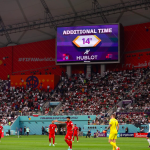
The problem with additional time in the World Cup
A controversy that has revived the proposal to use actual time
November 25th, 2022
The big topic during these first matches of the controversial World Cup in Qatar has not been the tents hospitality for the fans, or the ban on rainbow captain's armbands, or the even more serious violations of human rights. What took the stage at the most important event in international football were the injury time minutes, the many, many interminable injury time minutes that are stretching these early matches out of proportion. It started directly for the opening match of this World Cup, the one between hosts Qatar and Ecuador, with ten extra minutes added up between the two halves of play. But already in the next match between England and Iran, due to the injury of the latter's goalkeeper Alireza Beiranvand, the recovery time rose to twenty-seven minutes in a match without history.
A situation that was repeated in the other matches, all of which ended with double-digit recoveries and a sequence of controversies between the serious and the amused about how the matches never ended. In particular, the most incredible upset that saw Saudi Arabia surprise Messi's Argentina waited over twenty minutes before confirming its surprising ending. Lately, recovery minutes seem to have come relatively back under control, with durations ranging between five and ten minutes. That's a lot, however, for matches that hardly stay under 100 minutes in total, disrupting the TV and advertising calendar. Compared to the 2018 World Cup in Russia, when no match had exceeded ten minutes of total recovery time, there has been a marked turnaround.

The cause is to be found in the new directive from the IFAB (International Football Association Board), which has changed the way through which recovery is awarded. "We have recommended to our referees to be very precise in calculating the time to be added at the end of each half to compensate for time lost due to a specific type of incident. What we want to avoid is for a match to last 42, 43, 44, 45 minutes of active play. This is unacceptable. Let's imagine that in one half there are 2 or 3 goals scored, so it's easy to lose 3, 4, 5 minutes just for the celebrations. And this time has to be compensated at the end," as Pierluigi Collina, a prominent member of the IFAB, recently explained.
A rule that was not initially handled well by the referee teams, who were perhaps too generous and taxing in granting recoveries based on the rule and not on common sense, and which relaunched a discussion that has been gaining a lot of credence in recent years, that of actual time. Inspired by American sports or rugby, it was launched in 2017 by Marco Van Basten, then Head of Technological Innovation for FIFA, and later made a comeback in 2021 when it was experimented with two halves of 30 minutes each. According to Opta data, in fact, the time played in major European leagues ranges between 54 minutes and 28 seconds in the Spanish La Liga and 55 minutes and 45 seconds in the Premier League, a few minutes less than FIFA's request.
The proposal regarding actual time would also help to decrease the practice of time wasting more effectively than the deterrence of yellow cards, thus keeping matches within a well-defined time while also meeting the increasingly pressing demands of television. Moreover, this FIFA directive adds further discretion to the referees, which as these World Cups are also proving is not always a happy choice, instead of moving towards other solutions capable of automating the decision-making process, as already done with the semi-automatic Var. But despite all the controversy that these goofy additional times have generated, it does not seem to have changed the IFAB's agenda and indeed soon this novelty should also arrive in the national leagues, including Serie A. So get ready for matches that will no longer end in the 90th minute, and the maxi recoveries will not just be mirages in the desert.








































.png)


.jpg)





.png)


